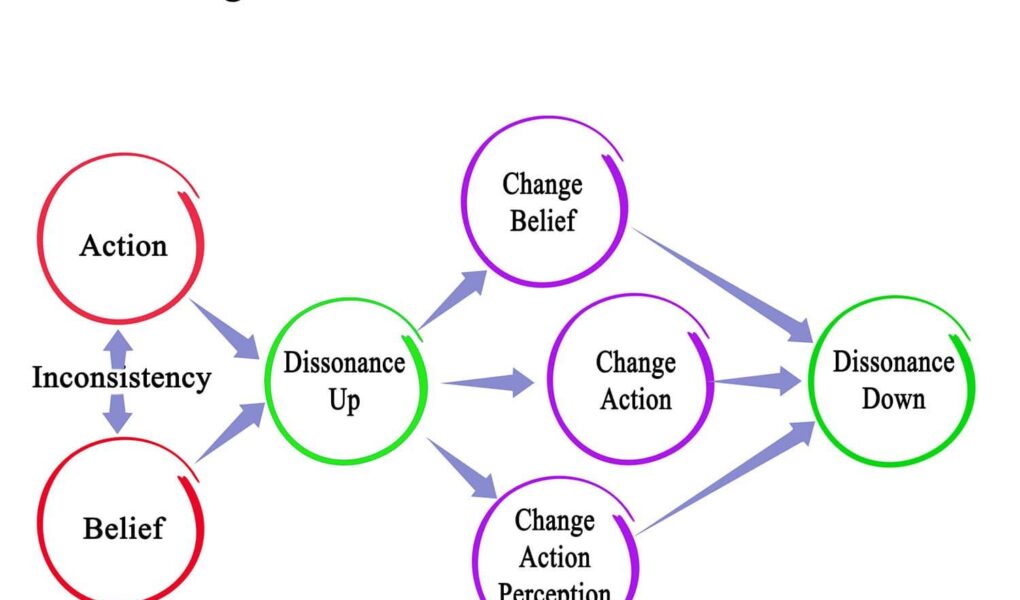Navigating the Mind’s Labyrinth: Cognitive Dissonance and Marijuana Use
In a world where choices abound and perspectives collide, the human mind often finds itself in a state of internal tug-of-war—a phenomenon known as cognitive dissonance. This psychological conflict arises when our beliefs and behaviors clash, prompting a deep dive into our motivations and values. As societal attitudes towards marijuana shift dramatically, many individuals grapple with the dissonance of enjoying cannabis while reconciling it with previously held beliefs about its legality, safety, and morality. This article explores the intricate interplay between cognitive dissonance and marijuana use, unraveling how this complex relationship shapes our perceptions, affects our decisions, and ultimately influences the ongoing dialogue surrounding one of the most controversial substances of our time. Join us as we delve into the mental labyrinth where pleasure and principle often collide, and discover the nuances of our evolving understanding of marijuana in contemporary society.
Table of Contents
- Exploring the Psychological Tug-of-War: Understanding Cognitive Dissonance in Marijuana Use
- Bridging the Gap: Navigating Conflicting Beliefs and Behaviors Surrounding Cannabis Consumption
- Strategies for Resolution: Practical Steps to Alleviate Cognitive Dissonance Related to Marijuana Use
- The Role of Education and Awareness: Empowering Choices Through Informed Perspectives on Cannabis
- Q&A
- Concluding Remarks
Exploring the Psychological Tug-of-War: Understanding Cognitive Dissonance in Marijuana Use
The allure of marijuana often walks hand in hand with a complex tapestry of conflicting beliefs and emotions. Many users find themselves in a state of psychological discomfort, or dissonance, as their experiences clash with societal norms and personal values. This internal struggle can manifest in a variety of forms, including:
- Justifying Use: Some individuals rationalize their consumption by emphasizing the benefits, such as relaxation or creativity, while simultaneously acknowledging the stigma surrounding marijuana.
- Feeling Guilt: Users may grapple with feelings of shame or guilt, particularly if they were taught from a young age that drug use is wrong, leading to a divided self-image.
- Avoidance of Confrontation: Many opt to avoid discussions about their use, creating an echo chamber where only favorable narratives about marijuana are entertained.
This inner conflict often prompts users to find ways to alleviate the discomfort caused by their beliefs and actions. Strategies can vary widely, including:
- Change in Belief: Adopting a more accepting view of marijuana use based on personal experiences or shifting cultural perceptions can help users reconcile their enjoyment with societal attitudes.
- Behavioral Adjustment: Some individuals may choose to reduce consumption or engage in responsible use as a response to their discomfort, aiming to align actions with values.
- Education and Support: Seeking information about marijuana’s medical benefits or joining community groups can empower users and provide a sense of belonging, helping to navigate their dissonance.
Bridging the Gap: Navigating Conflicting Beliefs and Behaviors Surrounding Cannabis Consumption
Cannabis consumption often treads a fine line between varying societal norms and personal beliefs. On one side, advocates argue for its medicinal properties and recreational enjoyment, while, on the other, opponents raise concerns about health risks and social implications. This disconnect can create a significant cognitive dissonance within individuals who may simultaneously hold a favorable view of marijuana for specific uses yet feel guilty or conflicted due to societal stigmas. The result is an internal tug-of-war that influences not only personal choices but also broader community perceptions of cannabis.
To mitigate this dissonance, it becomes essential to foster open discussions where differing perspectives can be expressed without judgment. Many people find it helpful to explore the nuances surrounding cannabis through various lenses. These can include:
- Cultural Context: Understanding how different cultures view cannabis can enrich perspectives.
- Scientific Evidence: Statistically derived information may sway opinion when backed by credible sources.
- Personal Stories: Hearing firsthand experiences can create empathy and bridge understanding.
By embracing a multifaceted approach to cannabis conversations and acknowledging the diverse beliefs surrounding it, we can better navigate personal choices and societal norms. This shift not only alleviates personal conflict but also promotes a healthier dialogue within communities, paving the way for mutual respect and understanding.
Strategies for Resolution: Practical Steps to Alleviate Cognitive Dissonance Related to Marijuana Use
To effectively address the conflicting feelings surrounding marijuana use, it is essential to adopt practical strategies that solidify personal beliefs. Here are a few actionable steps:
- Education: Take time to research both the benefits and drawbacks of marijuana. Understanding the full spectrum of information can help reconcile conflicting views.
- Self-Reflection: Spend a few moments journaling about your experiences with marijuana. Reflect on how it affects your life, both positively and negatively, to clarify your stance.
- Seek Support: Engage in conversations with peers or online support groups. Sharing your thoughts can provide new perspectives and reduce feelings of isolation.
- Set Boundaries: Determine your limits regarding usage. Setting boundaries can minimize guilt and increase feelings of control over your choices.
Another vital aspect of alleviating dissonance involves realigning personal values with actions. Consider implementing the following approaches:
| Value | Action |
|---|---|
| Health | Limit intake to minimize adverse effects. |
| Responsibility | Utilize marijuana in responsible settings. |
| Personal Growth | Seek alternative activities that promote well-being. |
Consistency between beliefs and behaviors is crucial in overcoming cognitive dissonance. By reflecting on one’s values and aligning them with everyday choices, an individual can cultivate a more harmonious relationship with marijuana use.
The Role of Education and Awareness: Empowering Choices Through Informed Perspectives on Cannabis
The relationship between education and awareness plays a significant role in shaping perceptions surrounding cannabis. As individuals navigate the complexities of marijuana use, misinformation can lead to cognitive dissonance—the mental discomfort experienced when confronted with conflicting beliefs. To alleviate this dissonance, it is crucial to offer clear, evidence-based information that allows consumers to make informed choices. By fostering an environment where education thrives, individuals are empowered to explore the multifaceted nature of cannabis, from its therapeutic benefits to potential risks, enabling them to develop a more comprehensive understanding of the substance.
Incorporating various educational strategies can further enhance awareness and reduce cognitive dissonance regarding cannabis. Consider hosting community workshops, creating online resources, and distributing informative literature. These initiatives could help people grasp the complexities of cannabis use. Below is a simple table demonstrating effective educational approaches:
| Educational Approach | Objective |
|---|---|
| Workshops | Engage participants through interactive discussions. |
| Online Resources | Provide accessible information for self-learning. |
| Informative Literature | Convey key facts and dispel myths. |
Q&A
Q&A: Understanding Cognitive Dissonance in the Context of Marijuana Use
Q1: What is cognitive dissonance?
A: Cognitive dissonance is a psychological term that describes the mental discomfort or tension that arises from holding two conflicting beliefs, values, or attitudes. This phenomenon often leads individuals to change their beliefs or behaviors to alleviate the discomfort and achieve internal consistency.
Q2: How is cognitive dissonance related to marijuana use?
A: Cannabis use can evoke cognitive dissonance in various ways. For instance, individuals who enjoy recreational or medicinal marijuana may also hold beliefs about its legality or health risks. This conflict between their actions (using marijuana) and their beliefs (marijuana is harmful/illegal) can create dissonance, leading them to rationalize their behavior or alter their beliefs.
Q3: Can you provide an example of cognitive dissonance experienced by marijuana users?
A: Certainly! A common scenario involves a person who smokes marijuana but believes that it negatively impacts motivation and productivity. They may experience dissonance as they try to justify their use, perhaps telling themselves that their specific use enhances creativity or relaxation, thereby aligning their behavior with a more favorable belief.
Q4: What are some common strategies people use to cope with this dissonance?
A: People often employ several strategies to reduce cognitive dissonance, including:
- Rationalization: They create excuses for their behavior, such as saying, “I only use it on weekends to unwind.”
- Changing beliefs: They may shift their opinion on marijuana, coming to see it as a beneficial substance rather than harmful.
- Avoidance: Individuals might distance themselves from contrary information about marijuana to lessen feelings of dissonance.
Q5: How does cultural perception influence cognitive dissonance surrounding marijuana?
A: Cultural narratives around marijuana have been shifting, particularly with increased legalization and acceptance. In areas where marijuana is viewed positively, users may avoid dissonance by aligning their beliefs with societal norms. However, in more conservative cultures, individuals may struggle more with the tension between use and prevailing negative attitudes, intensifying the cognitive dissonance experienced.
Q6: Are there any long-term effects of this dissonance on an individual?
A: Persistent cognitive dissonance can lead to stress and anxiety. In the context of marijuana use, prolonged dissonance might result in an individual feeling conflicted about their identity as a user, potentially leading to reduced self-esteem or a sense of guilt. Conversely, successfully resolving dissonance through acceptance or therapeutic measures can contribute to improved mental well-being.
Q7: Can recognizing cognitive dissonance lead to personal growth?
A: Absolutely! Acknowledging and confronting cognitive dissonance can foster deeper self-awareness and introspection. Individuals may discover their core values and beliefs, leading to a more integrated self. This journey can result in healthier behavior patterns and a stronger alignment between one’s actions and personal beliefs.
Q8: What should readers take away from this discussion on cognitive dissonance and marijuana?
A: Understanding cognitive dissonance in the context of marijuana can illuminate the complexities of human behavior, particularly regarding substances that straddle the lines of legality, culture, and health. By recognizing and addressing this dissonance, individuals can engage in more thoughtful conversations about their choices and the broader implications of marijuana use in society.
Concluding Remarks
As we draw the curtain on our exploration of cognitive dissonance and marijuana, it’s evident that the intersection of psychology and substance use is a complex landscape, rich with nuances and contradictions. The mind’s ability to harbor conflicting thoughts and beliefs can lead to both profound insights and perplexing dilemmas, particularly in realms as culturally charged as cannabis consumption.
Whether one finds solace in the soothing embrace of marijuana or grapples with the dissonance of societal norms and personal beliefs, it’s clear that this dialogue invites reflection and understanding. As we continue to navigate the ever-evolving perceptions of cannabis in our lives and societies, the echoes of cognitive dissonance serve as a reminder of the intricate dance between our values, choices, and the narratives we construct around them.
In this ever-shifting conversation, we encourage readers to remain open-minded and critical, embracing the complexities involved. After all, the journey towards understanding our thoughts and behaviors—especially in relation to such a multifaceted subject as marijuana—is as enlightening as it is essential.


